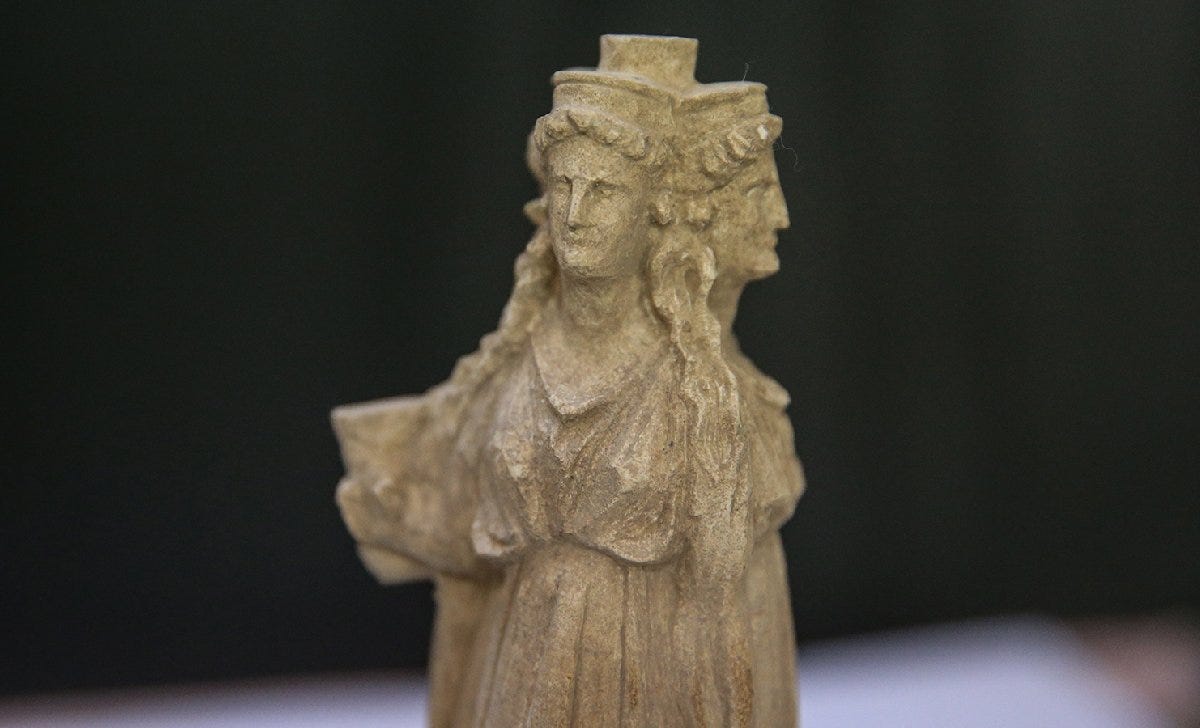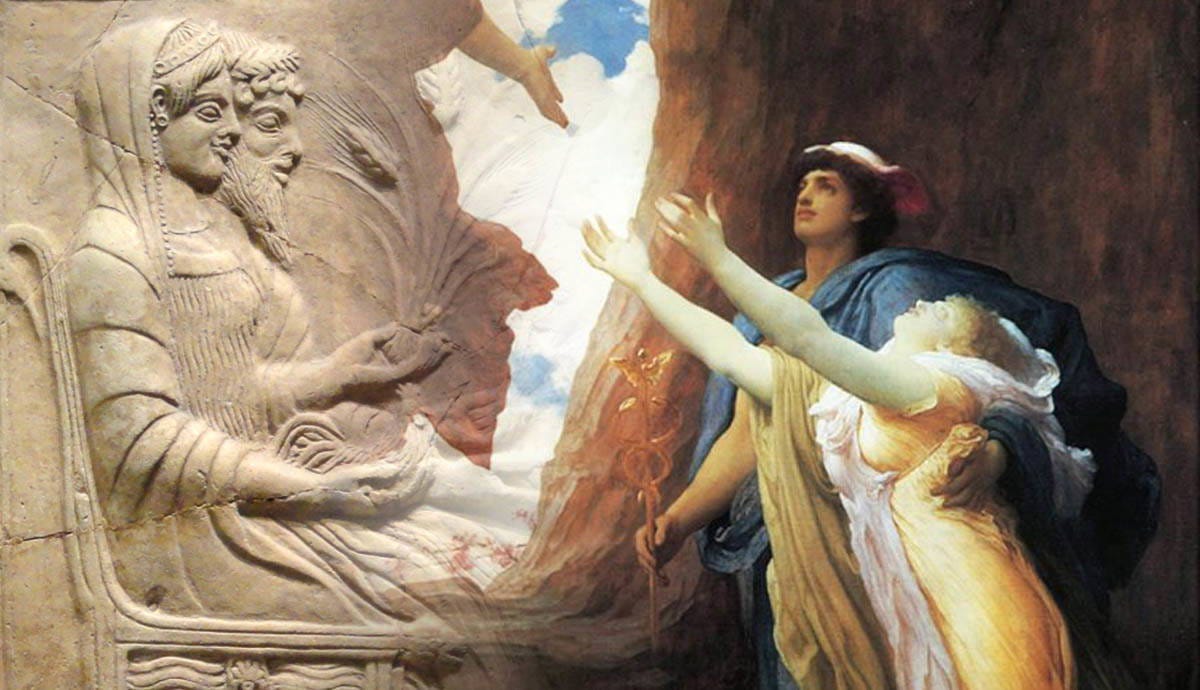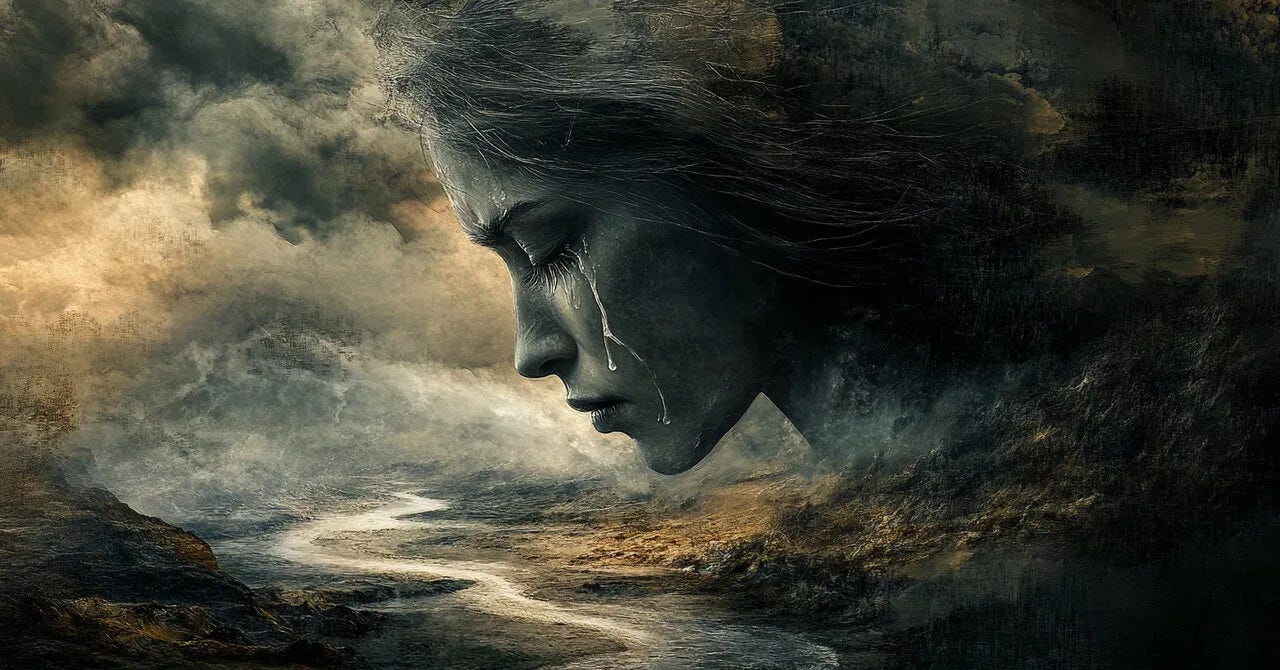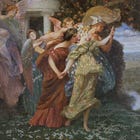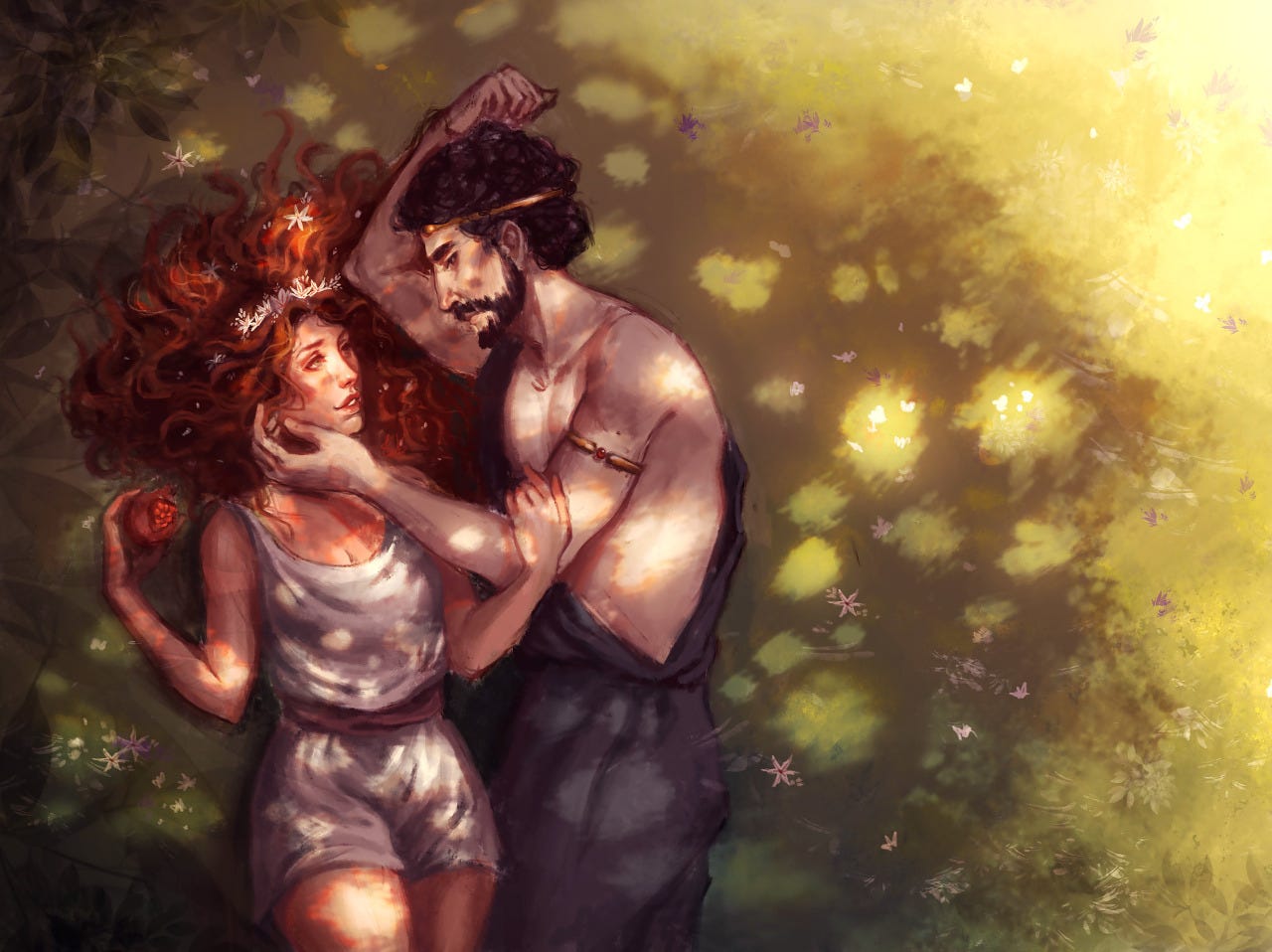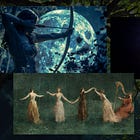Persephone’s descent into the underworld is not just abduction, it’s initiation. Hecate is her shadow guide: witch of crossroads, liminality, and forgotten paths. Hermes is the psycho-pomp, escort of souls. Together, they form her true allies in becoming Queen of the Underworld, not a victim, but a sovereign. This is the deep journey into the unconscious mother-complex and the pattern of our own self-abandonment, what I coined the Ghost Mommy role. Persephone begins as the maiden in service to others’ needs, who is chained to the mother archetype, not her Sovereign Self. Both Hecate and Hermes are her guides, through which she navigates death, grief, sexuality, and agency. The caretaker role dissolves as the soul encounters grief, rage, and its own mystery. So you become the one who walks others through shadow, because you walked yourself through first.
Yet whilst, Hermes journeyed into the depths of the underworld, it was Hecate, the goddess of witchcraft and magic, who ultimately rescued Persephone. Emerging as if ascending a staircase from a cleft in the earth, Persephone was guided by Hecate, who held two torches, while Hermes stood nearby. This is whilst Persephone represents the maiden, and inner child, within her own myth, it is Hecate as Sovereign goddess and a symbol of the empowered feminine, what the Jungians call the Self, that true saves her.
Reclaiming the Sovereign Feminine
It is the maiden, being freed from the unconscious bond to her own mother, through reconnecting with her inner Sovereign Feminine Self. Which Hecate, who is another form of Artemis, makes possible. Where Artemis guides women into the wilderness, to reclaim their wildness, it is in the form of Hecate, that she guides them into the depths of the unconscious (the underworld), to face the repressed emotions she has. Those who shackled her to the ghost mommy role, that becomes the one who gives, without receiving. In Greek mythology, Hecate was believed to have the power to grant or withhold, she much like Artemis had a backbone made from moonlight. 🐻🌕
The Triple Goddess: Persephone, Hecate and Cosmic Mother
What is even more interesting is that in the ancient days, Persephone and Hecate were both seen as child of Demeter, sometimes Persephone was even conflated with her. Different aspects of the same original goddess. Persephone (pre-Queen) as the Maiden, Demeter as the Mother, and Hecate as the Crone. Hecate was also called the goddess of many names. And in the night she shakes her mystic torch in her hand, called night-wanderer. She is Hecate Selene, the Moon in Heaven; And is Artemis the Huntress on Earth and Persephone the Destroyer in the Underworld. Sometimes she was even part of the Queen of Heaven Trinity: Hebe the Virgin (Aquarius), Hera the Mother and Hecate the Crone.
Orphic Hymn to Hecate
"Hecate Einodia, Trioditis,
lovely dame, of earthly, watery, and celestial frame,
sepulchral, in a saffron veil arrayed,
pleased with dark ghosts that wander through the shade;
Perseis, solitary goddess, hail!
The world's key-bearer, never doomed to fail;
in stags rejoicing, huntress, nightly seen,
and drawn by bulls, unconquerable queen;
Leader, Nymphe, nurse, on mountains wandering,
hear the suppliants who with holy rites thy power revere,
and to the herdsman with a favouring mind draw near."The Primordial Archetype: Hecate as the Daughter of Nyx
So as much as Artemis is the daughter of the Sovereignty Goddess, similarly to how Persephone is a child of the Sovereign Goddess Demeter, in the most ancient sense Hecate is the daughter of Nyx. In that form as Lucia Nyktelios, as I named her, before this child of Nyx fragmented, she embodied the qualities of Hecate, Artemis and also Persephone combined. Thus offering a pathway beyond the cosmic order. Where the maiden Persephone still operates within it the dualistic tension of the cosmos. Where she cycles between the underworld of winter and upper world of spring.
“I didn’t want to go. But now that I’m here, I make the darkness bloom.” - Persephone
Persephone as a Reflection of Our Own Struggles
This myth is ancient, older than civilization. Persephone didn’t choose the descent. She was taken, snatched from sunlight and flowers, pulled into a world of shadow and stillness. Sound familiar? For many of us, depression, numbness, or anxiety feels like that, like falling through the cracks of a life we were supposed to enjoy. Like we woke up in the Underworld with no idea how we got there. But here’s what the myth never really tells you: the descent is part of the rebirth. Not the failure of it.
🍂 Stage One: The Fall – Adapting to Survival and Disconnect
You might feel:
Tired but wired.
Disconnected from your body.
Scared of your own feelings.
Craving silence, solitude, or endless comfort content.
Replaying old childhood patterns (fawning, shame, self-blame).
This is the part where Persephone is pulled down. In practical terms, it's often a trauma response, a freeze or fawn state. You're not broken. You're adapting. You're trying to survive.
How to hold yourself here:
Wrap up in a blanket like a burrito.
Let your plushies or stuffies be your Underworld guardians. (Yes, really. Cerberus but cuddly.)
Find your Underworld playlist, the songs that don’t ask you to feel better, but just feel.
Watch comfort shows, even if your inner critic says it's silly. You’re not wasting time. You’re co-regulating.
😭 Stage Two: The Grief – Encountering the Depths of Emotional Pain
Eventually, something begins to stir. Maybe it’s a memory of being small and needing something you didn’t get, affection, safety, to just be without having to perform. Or maybe it’s anger at how long you’ve had to hold yourself together.
This is the river Lethe: the grief of forgetting who you were before. But it’s also the grief of remembering. When we push it away, we drink from the river Lethe, but if we allow ourselves to feel, we drink from Mnemosyne. In the myth about Dionysus, it is from that river that the initiates drink. It is both memory, but with grief. The grief of the child lost, what could have been. And the grief of Persephone as mother and queen of the underworld. In the story it is her, that holds her child, whilst they both cry together. Holding each other. Like a warm hug.
She tells you “Hey. I see you. You’re not weird for still grieving what you never got.”
What it looks like:
Sudden waves of sadness.
Crying without knowing why.
Feeling like a child inside your adult body.
Longing for a parent who never showed up the way you needed.
How to hold yourself here:
Sit with your inner child. Like, literally. Close your eyes, imagine 5-year-old you, and ask: What do you need right now? Then try to give it.
Say out loud: It’s okay to grieve what I didn’t get.
Journal with no agenda. Let the pain be a river.
Hug a plushie. Rock gently. Offer the kind of presence you always needed, even if it feels awkward.
🌱 Stage Three: The Return – The Rebirth into Your True Self
In her own myth, Persephone doesn’t stay in the Underworld forever. She chooses to return. And she doesn’t come back the same. She brings seeds with her. Where in the myth of Dionysus, the child similarly returns. From the underworld, back to the land of spring, joy and blooming vegetation. To what the ancient initiates called the kingdom of happiness.
Your rebirth isn’t about being “better.” It’s about being truer. More you. Rooted in your grief. Softened by your sadness. Lit by a tiny flame that only exists because you let yourself feel, break down into the truth of you. Moment by moment.
What it might look like:
Laughing again, softly.
Wanting to clean your room for you.
Having boundaries that feel sacred, not scary.
Feeling like life might be worth it, even if it still hurts.
How to hold yourself here:
Make tea. Light a candle. Thank your past self for surviving.
Rebuild life around coziness, not performance.
Let your inner child decorate your altar, your room, your life.
Celebrate small wins like Persephone bringing spring: gently, slowly, with flowers and rain.
🕊️ Final Note: You’re not failing. You’re cycling.
The Persephone myth is seasonal. You’ll descend again, and rise again. That’s not weakness, that’s life. That’s being human. That’s being a soul in a body, in a world that forgot how to be soft. But you’re remembering. Every time you cry. Every time you rest. Every time you hold your own hand in the dark.
You are both the one who descends and the one who returns. You are the seed, the soil, and the spring. Yet you are also not alone. Even if you might right now have no one to hold you. Persephone as figure, as much as Lucia Nyktelios (as the primordial Hecate), are there within you. Existing as the archetypal mother, who grieves with you, who feels with you. Who knows your tears, who loves her child. Not because of what you can be, but because of who you are, in every moment. Even if right now you are not feeling ok, even if right now tears fall. Even in that moment you deserve love, to be held, to be seen. Without being fixed, or told not to feel. Persephone and Lucia Nyktelios teach that your tears are sacred expressions. Of your inner child. She is a daughter of Nyx, mother of all mystery and wild sorrow. And you much like her are a child of Nyx too. A child of the mystery of life, in all your tears and joy.
“You were not broken.
You were becoming.
You were not weak.
You were waiting to be seen.
You were not a burden.
You were sacred, even in the silence.”
The Power of Grief and Love: Embracing Your Sacred Tears
You can stop trying to be okay now. You are not wrong for feeling grief, for feeling sad regarding the things you never had. You don’t have to be happy. Being happy is not the same as ok. Being okay, is to be real. To be authentic and feel. Even if what you feel is grief about your childhood. As tears are not a sign of wrongness, they are a sign that you like Persephone are feeling and trying to heal. Know that your grief is sacred because you are. You are not failing to be healed because you’re still grieving.
You are healing because you are finally grieving.

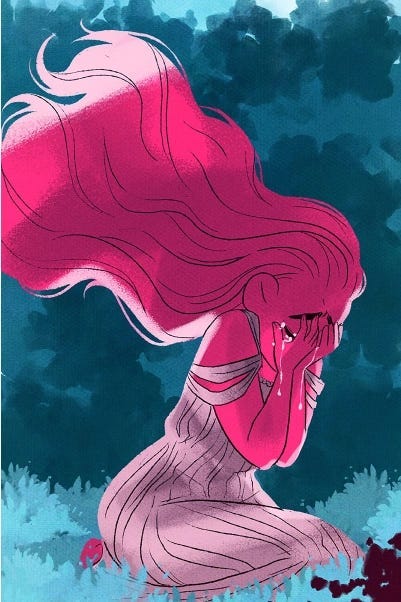
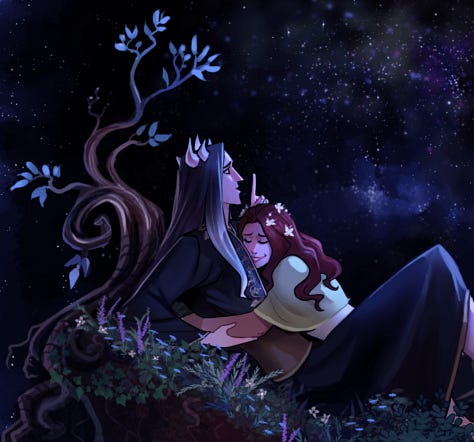
One secret that Lucia Nyktelios once told me in a dream, is that grief and love are not the opposite. When you lose someone, or have never had someone to hold you, to love you in the way you should have been loved. The grief about that is not just grief, it is about love. The love for the person you loved, and the love you should have had. Yet that very grief is the very sign that you can love, that your heart still exists. That you have the capacity for deep love, and with it the capacity to be loved in that same deep way. As to love is to be vulnerable, with yourself, which makes you able to do so with others. Love isn’t merely the realm of flowers that bloom. Love is the fire that burns in the deepest depths of the underworld. Which is there and holds one and others. To love is to hold someone, even in their grief and pain. Not just when it is all good and happy. True love is what includes the shadow, and can hold its grief.
As I know this personally. I have lost many people in my life. Quite a few that I deeply loved. So I am not a stranger to grief and depression. If the pain of loss, of unmet needs from childhood, taught me anything, it is that the very core of being, is love. Even if you descend into deepest reaches of the underworld and its darkness. Where you feel completely alone, without anyone there physically to hold you. To love you. To see your tears. Even within that darkness there is love. As love in the deepest sense lives within you, not just this external thing out there. As you are love, as much as I am. As love is Life itself, not the idealised fluffy kind. Love is a bear protecting her cub, a wolf mamma hunting for her tiny pup, a friend holding you in your grief. Even if just online. And if you do ever feel lonely, and you feel alone with your feelings. I want you to know that I write what I do, not for myself, but for you. Because I care about all who read this, who need this. So like Lucia Nyktelios, I am also a light in someone’s dark.




